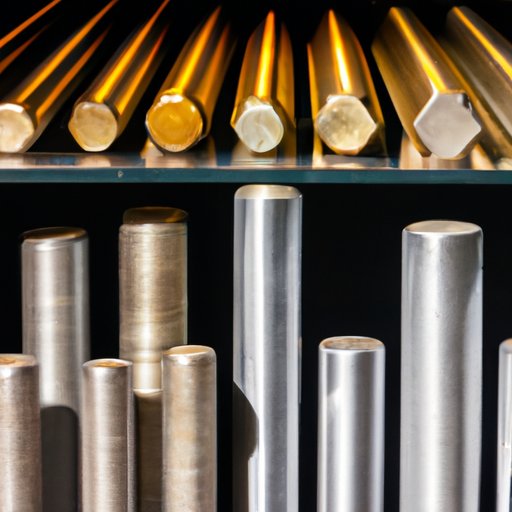Understanding Steel: Properties, Uses, and Evolution
Steel is an integral part of modern society, used in everything from bridges and buildings to vehicles and household appliances. However, many people may not be familiar with what steel is, its properties, and its long history. In this article, we’ll explore the world of steel, starting with its properties and uses, tracing its evolution from ancient times to modern day, examining its environmental impact, looking at how it’s been portrayed in pop culture, and finally, discussing what the future holds for this remarkable material.
II. Steel: Understanding its Properties and Uses
Steel is an alloy of iron and carbon, typically with a carbon content ranging between 0.2% and 2.1%. In addition to these two key components, steel may also contain other metals, including manganese, phosphorus, sulfur, silicon, and more. What sets steel apart from other metals is its unique combination of durability, strength, and versatility. Whether it’s used in construction, infrastructure, manufacturing, or other applications, steel is prized for its ability to withstand stress and strain.
One of the reasons that steel is such a popular building material is its range of uses. Steel is commonly used to build infrastructure such as bridges, roads, and railways, as well as to construct buildings and homes. But steel also has many other applications, such as in manufacturing automobiles, appliances, and equipment for the oil and gas industry, as well as in the production of alloys and other metals. Different types of steel are used in different contexts, depending on the desired properties such as strength, corrosion resistance, and flexibility.
III. The History of Steel: From Ancient Times to Modern Day
Steel has a long and fascinating history. Steel was first used in ancient civilizations, where small amounts of carbon were added to iron to create a stronger metal. By the Middle Ages, blacksmiths were creating steel through a process of heating and hammering iron and charcoal together, but this was a laborious and time-consuming process. It wasn’t until the Industrial Revolution in the 19th century that the mass production of steel became possible. The Bessemer process, invented in the mid-19th century, allowed for the production of large quantities of steel at low cost, making it possible to build skyscrapers, bridges, and other major engineering projects.
Since then, steel production has advanced significantly. Different processes have been developed, including the basic oxygen process and electric arc furnace, which have allowed for greater efficiency in the production of steel. Today, the steel industry is a vital part of the global economy, with millions of people working in the industry worldwide.
IV. The Environmental Impact of Steel Production
While steel has many benefits, it also has significant environmental impacts. Steel production is a major source of greenhouse gas emissions, with carbon dioxide and methane being released during the production process. The industry is also a major consumer of energy, much of which comes from non-renewable sources such as coal and natural gas. In addition, steel production generates significant amounts of waste. For instance, steel mills generate slag, a byproduct of the steelmaking process, which can contain hazardous materials such as lead and cadmium.
However, the steel industry is taking steps to mitigate these impacts. Companies are investing in new technologies that allow for more sustainable production methods, such as recycling scrap steel. In addition, governments worldwide are implementing policies aimed at reducing greenhouse gas emissions and promoting renewable energy sources.
V. Steel in Popular Culture: Iconic Steel Structures in Film and Television
Steel has also played a prominent role in popular culture. From the Golden Gate Bridge to the Eiffel Tower, steel structures have become icons of engineering and architecture. In film and television, steel is often used to create memorable structures that capture the imaginations of audiences. For instance, the Gateway Arch in St. Louis, Missouri, is featured prominently in the film National Lampoon’s Vacation, while the Chrysler Building in New York City has been depicted in countless films over the years.
Why has steel become such a popular material for these structures? For one thing, steel is incredibly strong and durable, making it an ideal building material. In addition, it can be shaped and molded into a variety of forms, making it possible for architects and engineers to create unique and memorable structures.
VI. The Future of Steel: Advancements in Technology and Innovation
The future of steel looks bright. Researchers and engineers are constantly developing new types of steel, using different materials and production techniques to create alloys that are lighter, stronger, and more resilient than ever before. In addition, new production methods, such as direct reduced iron, have the potential to greatly reduce greenhouse gas emissions and other environmental impacts.
As steel continues to evolve, it will remain an essential part of modern society. Whether it’s used to build a new skyscraper or manufacture the latest high-tech gadget, steel will continue to be prized for its strength, durability, and versatility.
VII. Conclusion
In conclusion, steel is one of the most important materials in modern society, playing a vital role in everything from construction and infrastructure to manufacturing and popular culture. With its long history, unique properties, and significant impact on the environment, steel is a fascinating and complex material. But as the industry continues to innovate and develop new methods and materials, steel will remain an essential part of our world for many years to come.
